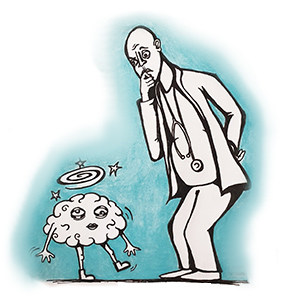For health professionals
Return to sport protocol
 Return to sport protocol
Return to sport protocol
Allow 24 hours as a minimum between each stage, if symptom free. Go back one step if symptoms resume.
| Stage | Functional exercise | Objective |
| 1. No activity | Complete physical and cognitive rest. | Recovery |
| 2. Light aerobic exercise | Walking, swimming or stationary cycling for 10 to 15 minutes, keeping intensity <70% maximum permitted heart rate. Avoid resistance training and other heavy lifting. | Increase heart rate |
| 3. Sport specific exercise | Running and throwing drills. Avoid body contact, resistance training, heavy lifting and other jarring motions. | Add movement |
| 4. Non contact training drills | Progression to more complex training, eg passing / press drills. Start progressive resistance exercises but avoid impact activities. | Exercise, coordination and cognitive load |
| 5. Full contact practice | Following medical clearance, return to normal training activities. | Restore confidence and assess functional skills |
| 6. Return to play | Normal game play. | Full return to pre-concussion activities |
Return to study protocol
 Return to study protocol
Return to study protocol
Allow 24 hours as a minimum between stages 1 to 3 and 1 to 2 weeks as a minimum between stages 4 to 6, if symptom free. Go back one step if symptoms resume.
| Stage | Functional exercise | Objective |
| 1. No activity | Complete cognitive rest | Recovery |
| 2. Minor cognitive activity at home | Short periods (5 to 15min) of cognitive activity (homework) | Gradual, closely monitored increase in sub symptom threshold activities |
| 3. Moderate cognitive activity at home | Longer periods (20 to 30mins) of cognitive activity (homework) | Increase cognitive stamina, self paced activity |
| 4. Partial school entry | Part day of school attendance, plus 1 to 2 cumulative hours of homework | Re-entry into school with accommodation to maintain cognitive load below symptom threshold |
| 5. Gradual reintegration to school | Gradual increase to full day of school attendance | Increase cognitive stamina, gradual decrease of accommodations |
| 6. Full cognitive workload resumed | Catch up on essential missed work, re-introduce testing and assessments | Full return to school, recommended to commence RTP protocol |
Return to study for school administrators
Return to study for school administrators
Return to work protocol
 Return to work protocol
Return to work protocol
Allow 24 hours as a minimum between stages 1 to 3 and 1 to 2 weeks as a minimum between stages 4 to 6, if symptom free.
| Stage | Functional exercise | Objective |
| 1. No activity | Complete cognitive rest (Maximum of 1 to 2 days). | Recovery |
| 2. Minor cognitive activity and light aerobic exercise in/around home | Short periods (5 to 15min) of cognitive activity (texting / computer) and going for walks up to 10 to 15 minutes, simple chores. | Gradual, closely monitored increase in sub symptom threshold activities |
| 3. Moderate cognitive / physical activity in / around home | Longer periods (20 to 30mins) of cognitive activity (social media / TV) or housekeeping tasks. | Increase cognitive / physical stamina, self paced activity |
| 4. Part time work | Part day in work environment, consider 3 mornings a week (ie Monday, Wednesday, Friday) for 3 to 4 hours. Ensure one task at a time. | Re-entry into work environment with accommodation to maintain cognitive load below symptom threshold, commence GRTWP |
| 5. Gradual reintegration to work | Gradual increase to full work days (ie Monday, Wednesday, Friday), then onto a full working week with reduced responsibilities, time pressures and restricted duties. | Increase cognitive stamina, gradual decrease of accommodations, progress GRTWP |
| 6. Full time work and duties | Catch up on essential missed work, and plan out priorities. | Full return to work |
Return to work for the employer
Return to work for the employer
General practitioner education
General practitioner education
bpacnz better medicine - concussion slidecasts
Part 1: Identifying and diagnosing patients with concussion (external site)
Part 2: The management and education of patients with concussion (external site)
Last Updated:
25/08/2025


